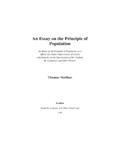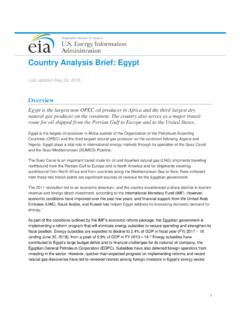Transcription of Linking Renewable Energy to Rural Development - OECD
1 Linking Renewable Energy to Rural Development Executive Summary Brief for Policy Makers 1 Executive Summary Renewable Energy (hereafter, RE) is being championed as a potentially significant new source of jobs and Rural growth in OECD countries, and a means of addressing environmental and Energy security concerns. In most countries, governments have invested large amounts of public money to support RE Development and are requiring significant quantities of it to be sold by Energy providers. But what are the economic impacts of these policies and investments? Can RE really help to develop Rural economies? These are some of the questions explored by this report, which presents the results of a two-year study of the impact of RE on Rural Development .
2 Drawing on case studies in 16 regions across europe and North America, it finds that while RE indeed represents an opportunity for stimulating economic growth in hosting communities, it also requires a complex and flexible policy framework and a long-term strategy. RE is not going to create lot of jobs, but rather some additional employment opportunities in Rural areas. Making a positive connection between RE Development and local economic growth will require more coherent strategies, the right set of local conditions, and a place-based approach to deployment. What does Renewable Energy offer Rural areas? The global deployment of RE has been expanding rapidly. For instance, the RE electricity sector grew by 26% between 2005 and 2010 globally and currently provides about 20% of the world s total power (including hydro-power).
3 Rural areas attract a large part of investment related to Renewable Energy deployment, tending to be sparsely populated but with abundant sources of RE. The case studies have found that RE deployment can provide hosting communities with some benefits, including: New revenue sources. RE increases the tax base for improving service provision in Rural communities. It can also generating extra income for land owners and land-based activities. For example, farmers and forest owners who integrating Renewable Energy production into their activities have diversified, increased, and stabilised their income sources. New job and business opportunities, especially when a large number of actors is involved and when the RE activity is embedded in the local economy.
4 Although RE tends to have a limited impact on local labour markets, it can create some valuable job opportunities for people in regions where there are otherwise limited employment opportunities. RE can create direct jobs, such as in operating and maintaining equipment. However, most long-term jobs are indirect, arising along the Renewable Energy supply-chain (manufacturing, specialised services), and by adapting existing expertise to the needs of Renewable Energy . Innovations in products, practices and policies in Rural areas. In hosting RE, Rural areas are the places where new technologies are tested, challenges first appear, and new policy approaches are trialled. Some form of innovation related to Renewable Energy has been observed in all the case studies.
5 The presence of a large number of actors in the RE industry enriches the learning fabric of the region. Small and medium-sized enterprises are active in finding business niches as well as clients and valuable suppliers. Even when the basic technology is imported from outside the region, local actors often adapt it to local needs and potentials. Capacity building and community empowerment. As actors become more specialised and accumulate skills in the new industry, their capacity to learn and innovate is enhanced. Several Rural regions have developed specific institutions, organisms, and authorities to deal with RE deployment in reaction to large investment and top-down national policies. This dynamic has been observed both in regions where local communities fully support RE and in regions where the population is against potentially harmful developments.
6 Affordable Energy . RE provides remote Rural regions with the opportunity to produce their own Energy (electricity and heat in particular), rather than importing conventional Energy from outside. Being able to generate reliable and cheap Energy can trigger economic Development . Key challenges Renewable Energy policy is expected to deliver in three areas: Energy security, climate change mitigation, and economic Development (job creation). However, this is not always the case and there can be significant trade-offs among them. For instance, large biomass heat and power plants can generate new employment opportunities in Rural communities, but may have a negative CO2 balance due to land-use change and transportation of feedstock over relatively long distances.
7 Similarly RE is in most instances a capital-intensive activity, and Energy as a whole represents a small share of employment in regional economies. Small-scale installations typically source labour and equipment from international suppliers, so the impact at the community level in terms of job creation is rather limited. Listed in the table below are some of the factors helping or hindering Renewable Energy in achieving its three goals. Focusing on ensuring the supportive ingredients are present will be a step forward in putting Renewable Energy to work in Rural communities. 2 Supportive Impeding High quality RE resource Low to moderate quality RE resource Relatively expensive current Energy Low-cost conventional Energy Provision of small subsidies Provision of large subsidies Ability to link RE to existing economic activity RE is a standalone sector within the regional economy Good existing Energy transport/transmission infrastructure Project produces stranded Energy that cannot be exported Strong local community support Significant local opposition Integration of RE within a broader Energy framework that facilitate dispatch Inadequate backstop Energy for intermittent power sources Mature technology Novel or infant technology RE relies on regional inputs that have limited current uses/RE complements existing input uses Inputs
8 For RE project have high opportunity cost in current use RE policy aims at producing cheap Energy ( Renewable heat) Excessive focus on job creation absorbs large quantity of public resources that could be better spent connecting RE to the Rural economy Putting Renewable Energy to work in Rural areas A well-designed framework for regional policy could offer a real opportunity to reconcile policy trade-offs and identify potential complementarities among the three objectives of Energy security, climate change mitigation, and job creation. These findings underline the need for a shift in the approach to Rural Development policy in many OECD countries away from a model that emphasises sectoral policy and subsidies, to one that is place-based and grounded in local conditions and opportunities and that focuses on the competitiveness of Rural areas.
9 Specific factors to bear in mind include: Embed Energy strategies in the local economic Development strategy so that it reflects local potentials and needs. Environmental and Energy security arguments tend to be the main impetus for promoting Renewable Energy , and the local economic benefits tend to get overlooked. Integrate RE within larger supply-chains within Rural economies, such as agriculture, forestry, traditional manufacturing and green tourism. Limit subsidies in both scope and duration, and only use them to induce RE projects that are close to being viable in the market. If subsidies are too high, they can attract rent-seeking investors, can lead to high-cost Energy that is only viable as long as high levels of subsidy are sustained, can have a negative impact on land use and displace other activities such as agriculture and tourism.
10 Avoid imposing types of RE on areas that are not suited to them. For example, wind power is only appropriate in certain places more care is needed to identify those places rather than adopting policies that somewhat arbitrarily spread RE projects across national landscapes. Focus on relatively mature technologies such as heat from biomass, small scale hydro and wind. These proven technologies are not likely to experience big jumps in technology that can make recently completed plants instantly obsolete. Create an integrated Energy system based on small grids able to support manufacturing activities. Policy should take into account backstop technologies for intermittent power sources. In several regions, the capacity to deploy RE is constrained by grid limitations; however, there are no incentives to improve transmission infrastructure.















